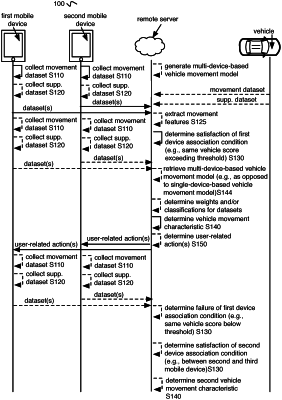| CPC H04W 4/40 (2018.02) [G08B 21/04 (2013.01); G08B 25/016 (2013.01); G08G 1/205 (2013.01); H04W 4/023 (2013.01); H04W 4/027 (2013.01); G08G 1/162 (2013.01); H04W 4/026 (2013.01)] | 20 Claims |

|
1. A method for a plurality of mobile devices in a vehicle, the method comprising:
with a first computer onboard a first mobile device, receiving at least a portion of a first movement dataset corresponding to a first sensor of the first mobile device of the plurality of mobile devices, wherein the first movement dataset comprises at least one of: position, velocity, and acceleration data;
with a second computer onboard a second mobile device, receiving at least a portion of a second movement dataset corresponding to a second sensor of the second mobile device of the plurality of mobile devices, wherein the second movement dataset comprises at least one of: position, velocity, and acceleration data;
based on an at least partial overlap between the first and the second movement datasets, determining, with a remote computer in communication with the first and second computers, satisfaction of a device association condition indicative of the first and the second mobile devices residing in the vehicle; and
based on determining the satisfaction of the device association condition and with the remote computer:
with a trained machine learning multi-device-based vehicle movement model and the first and second movement datasets, determining a vehicle movement characteristic comprising a driver classification associated with a user of the first mobile device; and
initiating an action based on the driver classification, wherein the action comprises: collecting additional data of the first movement dataset; and ceasing collection of additional data of the second movement dataset.
|